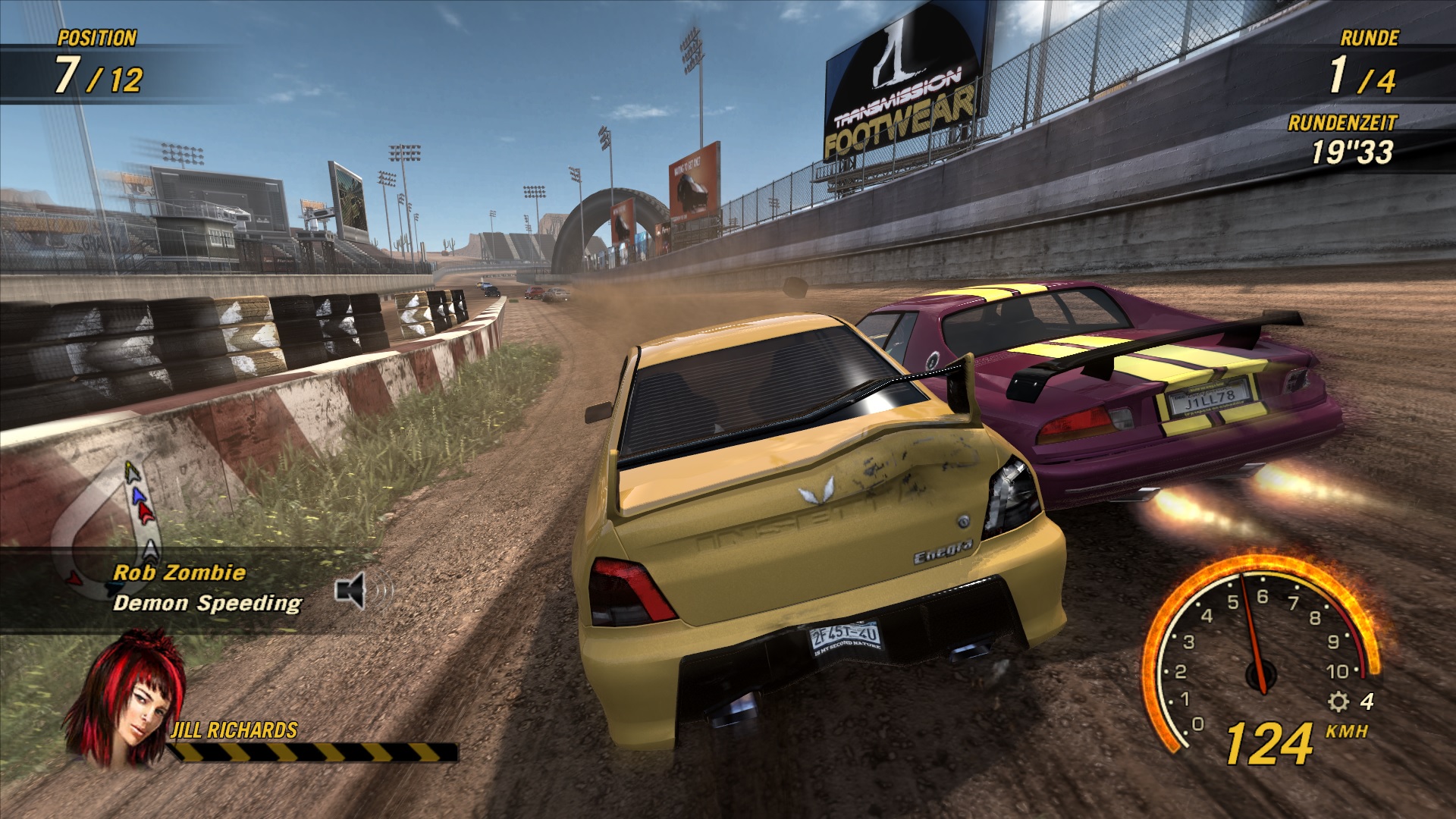

A game that always offered frantic, edge-of-the-seat racing is now even more frenetic. Upping the car count from FlatOut 2’s eight to twelve has a huge impact on the gameplay. More importantly, Ultimate Carnage packs in more cars and more destructible scenery into each and every race. In motion, Ultimate Carnage looks utterly fabulous. At any one moment there can be eight or nine cars, rich vegetation, shattered scenery, showers of particle-based spark effects and oodles of rippling, splashing, reflective water all competing for attention on the screen, and yet the frame rate seems happy to sit at darn near 60fps. Colin McRae: DIRT trumps it for realistic detail, and the car models – all inspired by rather than based on real cars – don’t match up to those in Forza 2 or Project Gotham 3, but what impresses is the sheer amount of stuff being thrown around by the engine without slowdown. We could compare polygon counts and dynamic lighting systems, but all you really need to know is that Ultimate Carnage takes one of the best-looking racers of the last generation and makes it one of the best-looking racers of this one. However, where other developers would be content to slap an extra layer of polish on the Xbox version and release it like that, Bugbear has taken the opportunity to make a kind of uber-FlatOut a FlatOut with everything turned up to eleven. This might not sound like the foundations of a great arcade racer, and neither will the fact that FlatOut: Ultimate Carnage is essentially a reworking of FlatOut 2, but for the Xbox 360. Think of FlatOut, then, as the sort of game that Jeremy Clarkson, Quentin Tarantino and Johnny Knoxville might come up with if they had been put in charge of the Burnout franchise. Carving your way through it isn’t just a vandalistic pleasure – it’s also a way of earning vital supplies of boost, and the same goes for smacking into rival cars. Each track is festooned with rickety buildings, fences, oil tanks, carelessly abandoned furniture and scrapped vehicles, and the vast majority of it is designed to be knocked about, wrecked and destroyed. At its best, Burnout is all about the near-miss about plotting your way through the traffic, taking calculated risks, chaining boosts together and avoiding collisions. Of course, this doesn’t really do justice to either game. In fact, last year’s FlatOut 2 aped Burnout’s slick presentation and shouty music soundtrack to the extent that it was getting difficult to tell which was which.
Xbox 360 flatout ultimate carnage cheats driver#
And while Burnout has its Crash mode, FlatOut has its destruction derbys and stunt modes, where players compete in a series of bizarre events centred on throwing the driver through the windscreen at high speed towards a set of skittles or a series of flaming hoops. It copies Burnout’s boost system with a similar gauge powered by damage caused to the environment and inflicted on either competitor cars or the player’s own ‘rag-doll’ driver. Now, FlatOut hasn’t got Burnout’s killer feature – traffic – but it offers an alternative with arguably the most interactive and destructible environments of any racer. You might want to go on holiday to Burnout-land (though you probably wouldn’t want to hire a car) but a visit to FlatOut-ville would probably be a bit like Deliverance. Both series focus on high-speed, adrenaline fuelled arcade racing with an emphasis on vehicular destruction, but where Burnout made its name with sleek machines and glossy, predominantly urban environments, FlatOut takes its action into the boondocks, with the tracks running around – and through – hick lakeside resorts, timber yards, industrial towns and farmsteads. Despite awards and critical acclaim, FlatOut has sometimes been dismissed as the dumb country cousin of EA’s brilliant Burnout series. To those of you who haven’t come across the franchise before, this might be a surprise. The fact is that, in my opinion, FlatOut: Ultimate Carnage is so close to being the best arcade racer on the planet that it hurts. See the seven lurking somewhere at the top of this page? It’s a sad seven – a seven that could have been so much more.


 0 kommentar(er)
0 kommentar(er)
